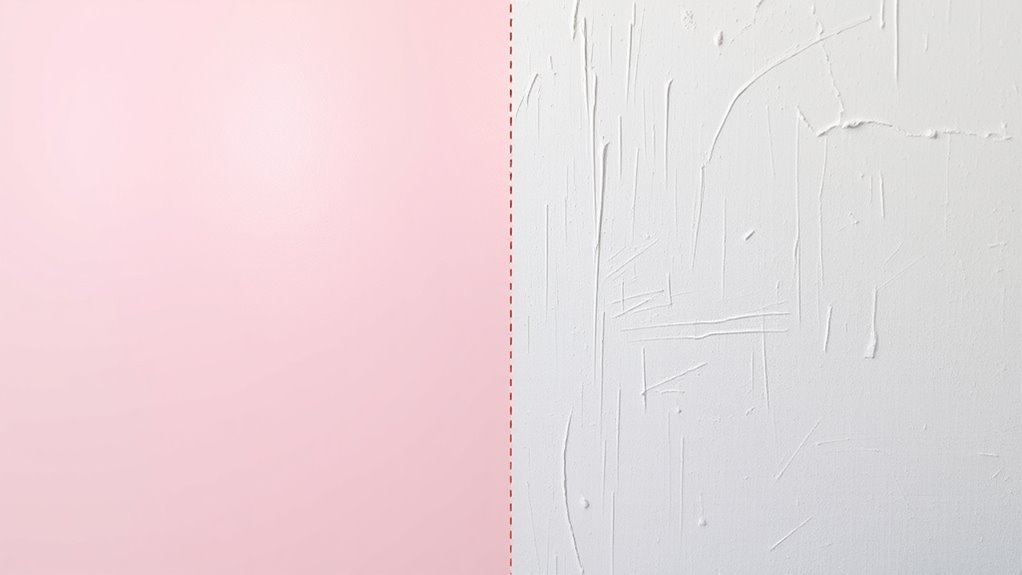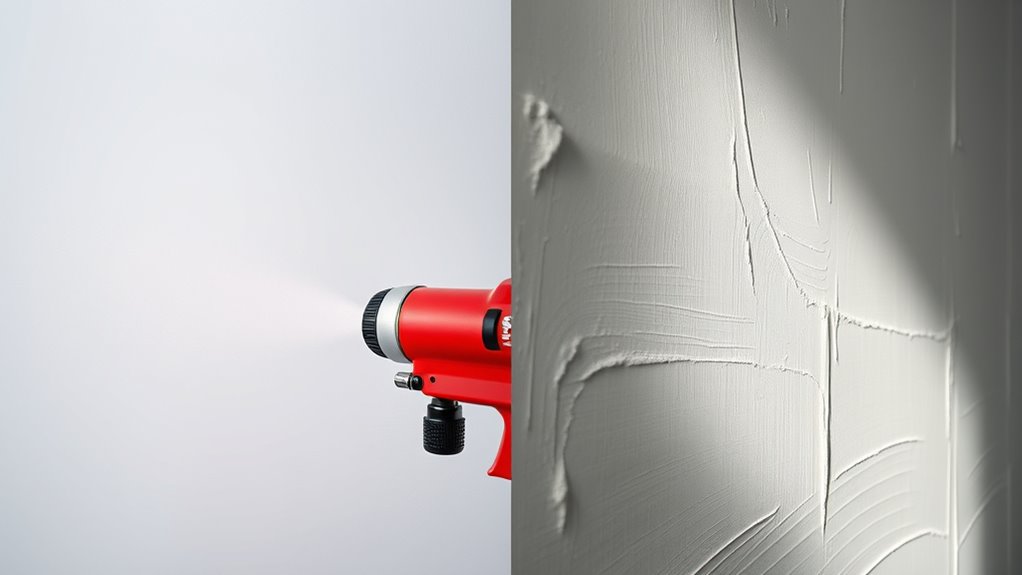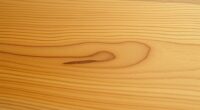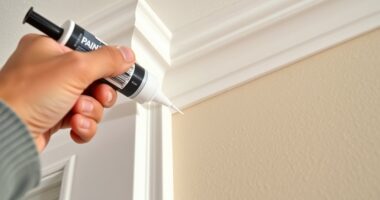Choosing between spray and brush depends on your project and conditions. Sprays provide a smooth, even coat ideal for large or detailed surfaces, but they’re sensitive to wind and humidity. Brushes allow precise application and thicker coats but may trap air or moisture, reducing durability. Proper surface prep and environmental control help both methods last longer. Keep exploring to discover how the right technique can maximize your paint’s longevity.
Key Takeaways
- Spray application provides a smoother, more uniform coat that enhances durability through better surface coverage.
- Brush application allows for thicker coats and precise work, which can improve durability on targeted surfaces.
- Environmental conditions like wind and humidity affect spray durability more than brushing, influencing long-term results.
- Proper surface prep and correct technique are critical for durability, regardless of whether spray or brushing is used.
- Overall, durability depends on how well the method aligns with surface type, environmental factors, and application precision.

When it comes to choosing a paint application method, durability often becomes the deciding factor. You want your paint job to last, resist chipping, and maintain its appearance over time. Your choice between spray and brush application depends heavily on understanding how application techniques influence durability and how environmental factors can impact the longevity of your paint. Spray application tends to provide a smooth, even coat, which can be beneficial for durability. The fine mist of paint from a spray gun ensures that the surface is coated uniformly, reducing weak spots where paint might peel or crack. This method is particularly effective for large surfaces or intricate details where precision matters. However, spray application can be more sensitive to environmental factors like wind, humidity, and temperature. These conditions can cause overspray or uneven drying, potentially compromising durability if not carefully controlled.
Choosing the right application method and environment ensures a durable, long-lasting paint finish.
On the other hand, brushing offers a more controlled application, allowing you to work in a steady, deliberate manner. With brushes, you can focus on specific areas, applying thicker coats where needed, which can enhance durability by providing a more robust paint layer. Brush techniques also enable you to work around obstacles and edges with precision. Nonetheless, environmental factors can influence brush application differently. High humidity or cold temperatures might cause the paint to dry unevenly, leading to cracking or peeling over time. Additionally, applying too thick a coat with a brush can trap air or moisture, weakening the bond between the paint and the surface.
Your environment plays a critical role in determining which application method will deliver better durability. For instance, if you’re working outdoors in windy or humid conditions, spray application might require additional precautions like masking or choosing the right type of spray paint designed for such conditions. Conversely, if you’re in a controlled indoor environment with stable temperatures and low humidity, brushing can produce a durable finish, especially when multiple thin coats are applied correctly.
In the end, understanding these application techniques and how environmental factors influence them is key. When you prioritize durability, consider not just the method but also the conditions under which you’ll be working. Proper surface preparation, choosing the right paint, and applying coats correctly—whether by spray or brush—will determine how well your paint withstands time, weather, and wear. Tailoring your approach based on these factors ensures that your paint job remains resilient and visually appealing for years to come.
Frequently Asked Questions
How Does Environmental Exposure Affect Spray and Brush Paint Durability?
Environmental exposure impacts both spray and brush paint durability, especially with humidity effects and UV resistance. When exposed to high humidity, paint can peel or blister, reducing longevity. UV rays can cause fading and deterioration over time. You should choose paints with strong UV resistance for sunny areas and consider humidity effects when selecting finishes. Proper preparation and protective coatings help maintain durability, regardless of application method.
Are There Specific Paint Types That Perform Better With Spray or Brush Application?
Like a tailored suit, certain paints fit specific methods perfectly. You’ll find that specialty paints, such as epoxy or urethane, often perform better with spray applications due to their smooth, even coating. Meanwhile, finishes like matte or textured paints may be easier to apply with a brush for detailed work. Your choice depends on your finish preferences and the paint’s formulation, ensuring durability and aesthetic appeal.
How Do Application Techniques Influence Long-Term Durability?
You can boost long-term durability by focusing on application techniques that guarantee consistency and a smooth finish. When you apply paint with care, avoiding streaks and uneven layers, the paint adheres better and resists peeling over time. Whether using a brush or spray, maintaining steady motion and proper technique helps achieve a uniform coat, which enhances durability. Proper preparation and application are key to lasting, beautiful results.
Does Paint Brand Impact the Durability Differences Between Spray and Brush?
Paint brand plays a pivotal role in durability differences, regardless of your application method. You’ll find that brands with consistent paint consistency promote smoother, stronger layers, whether sprayed or brushed. Higher-quality paints often enable quicker application speeds, reducing the risk of streaks or sags. So, when choosing a paint, prioritize reputable brands to guarantee prolonged durability, no matter how you apply it, and enjoy enduring, elegant results.
What Are the Cost Differences Considering Durability Over Time?
Considering cost efficiency, you should look at the longevity comparison of different paint types. While spray applications often have higher upfront costs, they can be more durable and last longer, reducing repainting expenses over time. Brushes may be cheaper initially but might need more frequent touch-ups. So, weigh the long-term durability benefits against initial costs to determine which method offers better value for your project.
Conclusion
So, which method truly stands the test of time? As you weigh the durability of spray versus brush, remember that the final verdict might surprise you. Will the sleek finish of a spray outperform the traditional touch of a brush? The results are closer than you think, and only one method will emerge as the ultimate winner. Ready to find out? Stay tuned—you won’t want to miss the reveal that could change your painting game forever.









